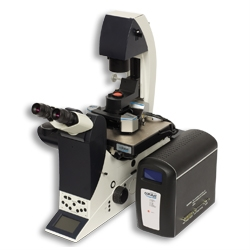Atomic Force Microscope
An atomic force microscope is a type of high-resolution scanning probe microscope that has a resolution that
you can measure in fractions of a nanometer. It operates using a sharp tip to scan extremely close to the surface
of the sample and measures the interactions between the tip and surface. Advantages of the AFM include high
resolution, versatility (can be used in air, liquid, or vacuum environments), and surface characterization.
There are contact and non-contact modes of operation that depend on whether the cantilever vibrates when
operating. Furthermore, there is also a tapping mode.
General Methods Description:
Samples were prepared by spin-coating onto standard AFM sample discs, mica, or silicon substrates to ensure a clean, flat, and stable surface. Imaging was performed using a Bruker Dimension Icon atomic force microscope in tapping mode with appropriate silicon cantilevers. Scan parameters—including drive amplitude, setpoint, and scan rate—were optimized to maintain stable tip–sample interaction and minimize artifacts. Height, phase, and amplitude images were collected simultaneously and processed using Bruker NanoScope Analysis software, applying only standard flattening and leveling to correct background curvature.
General Methods Description:
Samples were prepared by spin-coating onto standard AFM sample discs, mica, or silicon substrates to ensure a clean, flat, and stable surface. Imaging was performed using a Bruker Dimension Icon atomic force microscope in tapping mode with appropriate silicon cantilevers. Scan parameters—including drive amplitude, setpoint, and scan rate—were optimized to maintain stable tip–sample interaction and minimize artifacts. Height, phase, and amplitude images were collected simultaneously and processed using Bruker NanoScope Analysis software, applying only standard flattening and leveling to correct background curvature.
Dimension Icon AFM with SanAsyst
Resources:
Specifications:
Resources:
Specifications:
| Resolution | ~nm range and possible ~Am |
| Piezo | - XY piezo: 90 micrometers - Z piezo: 10 micrometers |
| Capabilities | - PeakForce Tapping - Contact mode - Tapping mode - MFM (Magnetic force microscopy) |
| Electricity | - CAFM (conductive AFM) - EFM (Electrostatic force microscopy) - KPFM (Kelvin Probe force microscopy) - PeakForce Tuna (PeakForce Tunnelling AFM) - EC-AFM (Electrochemical AFM) - IV curve |
| PeakForce QNM (PeakForce Quantitative Naomechanics) | - Young's modulus - Reduce modulus - Stiffness - Adhesion - Deformation - Dissipation |
| Temperature Range | -50 ~ 250 C |
| Nanolithography | Yes |

BioScope Catalyst AFM with ScanAsyst
Resources:
Specifications:
Resources:
Specifications:
| Resolution | ~nm range |
| Piezo | - XY piezo: 150 micrometers - Z piezo: 15-20 micrometers |
| Capabilities | - PeakForce Tapping - Contact mode - Tapping mode - MFM (Magnetic force microscopy - EFM (Electrostatic force microscopy) |
| PeakForce QNM (PeakForce Quantitative Nanomechanics) | - Young's modulus - Reduce modulus - Stiffness - Adhesion - Deformation |
| Temperature Range | ~40 C |
| Microscope Image Registration and Overlay (MIRO™) | Feature automatically imports and rescales light microscope images, allowing them to be used to direct the location of AFM imaging and force measurements |
